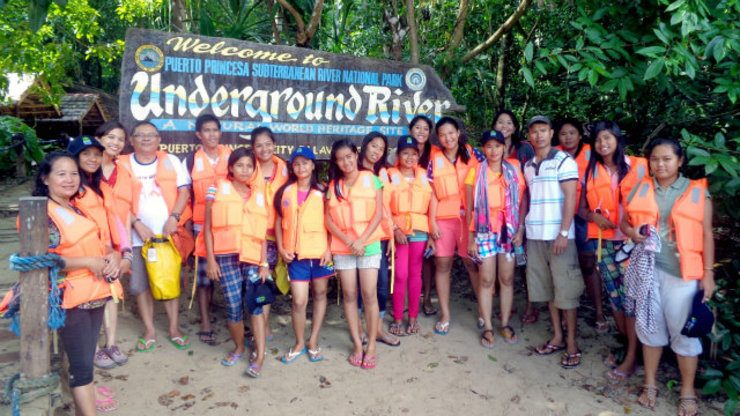SUMMARY
This is AI generated summarization, which may have errors. For context, always refer to the full article.

PALAWAN, Philippines — From Balabac, a remote coastal village in Palawan, came rich stories about fisherfolk, indigenous peoples, and endangered wildlife species. These were written by high school students who want to help protect the ocean by telling their stories.
“I am an ordinary ethnic Molbog who (was born) into a hard life like that of a water buffalo,” Elnah Basala, a student from Balabac National High School, said in Filipino.
Molbog is an indigenous group in the Balabac Island that has acquired a Visayan-Islam culture.
Basala’s story was about how her father, a respected tribe leader and former dynamite fisher, has adopted better fishing practices after a bungbong or homemade bomb, accidentally exploded in his hand.
“I was 13 when it happened. I can never forget it,” Basala said.
Dynamite kills not just the fish
Illegal fishing practices, such as those that use cyanide and dynamite, are common in Balabac. Some dynamites are homemade, fashioned out of highly combustible plant fertilizer mixed with gasoline and sulfur, and stored in an empty soda bottle.
The shock waves from the dynamite quickly kill schools of fish, making it easier to collect them. It also destroys reef ecosystems and greatly reduces fish yield over time.
In cyanide fishing, fishermen crush cyanide tablets into plastic squirt bottles of sea water and use the solution to stun and capture high-value live reef fishes, including the endangered mumphead wrasse or Mameng, and the coral trout or lapu-lapu.
But these illegal fishing practices pose great danger not only to the environment but also to the safety and health of fisherfolk and their families.
Dynamites can explode prematurely and can end up blowing off arms or legs, and even killing the fishermen.
Anti-hero turned hero
“My father is still a fisher, but he does so legally. He doesn’t need to put his life on the line to feed us. We have started to farm seaweeds, and father has volunteered to be an Ocean Patroller,” Basala said.
Basala hopes that her life story will become an inspiration for fishing families and encourage them to pursue sustainable fishing practices.
“Even if I live in an island, I have not seen these beautiful creatures under the sea. Maybe it’s because the Balabac waters have been damaged. I feel regret for the things we’ve lost in our island,” said Roozie Quea Idlana, another student who participated in snorkeling activities in Honda Bay.
The young authors participated in a two-day coastal resource management camp and eco-adventure tour in October 2014. The camp ushered realizations from the students about real-life environmental challenges, and their key part in helping to resolving these.
“The reefs are really so beautiful and now I’m determined to protect them,” added Idlana.
A unique learning experience, the camp focused on peer-review of the stories, exploration of ideas on how the youth can take lead in environmental stewardship, and first-hand familiarity on sustainable eco-tourism.
The eco-adventure tour consisted of 4 key sustainable and locally managed tourism sites in Puerto Princesa City: the Puerto Princesa Subterranean River National Park, Palawan Wildlife Rescue and Conservation Center, Iwahig Firefly Watching Ecotourism and Wildlife Park, and Pambato Reef and Pandan Island in Honda Bay.
Women, children, IPs
The children’s narratives provided insights on how they view the role of the youth, women, and the community in coastal resource management.
The stories discussed issues such as destructive fishing practices, illegal trade of endangered wildlife, importance of upland and mangrove forests and coral reefs, and climate change adaptation, among others.
All protagonists or narrators were young people, which included indigenous people and young girls and boys.
The stories will be published in a storybook entitled, Tales of the Coral Triangle in 2015, and will be distributed to networks in the Coral Triangle region spanning Malaysia, the Philippines, Indonesia, Papua New Guinea, Timor Leste, and the Solomon Islands.
The stories were the best 10 submitted to a story writing contest, which is part of the Bayani ng Kalikasan (Heroes of the Environment) campaign designed by the Coral Triangle Initiative-Southeast Asia project. The activity aims to enhance awareness, strengthen involvement, and mobilize the youth and the community in the management of coastal and marine resources. – Rappler.com
Lourdes Margarita Caballero is a development communicator and serves as the Knowledge Management Specialist of the Coral Triangle Initiative-Southeast Asia project.
Coral Triangle Initiative – Southeast Asia is a regional non-profit project funded by the Asian Development Bank and the Global Environmental Facility. It aims for climate resilience among coastal communities in Malaysia, Indonesia, and the Philippines.
Add a comment
How does this make you feel?
There are no comments yet. Add your comment to start the conversation.